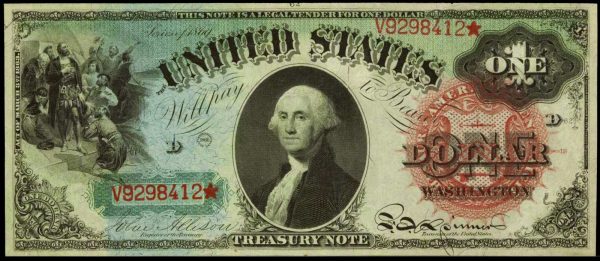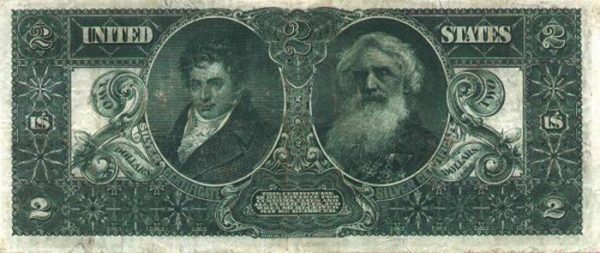Despite its historical importance and ubiquitous usage, the original meaning of the United States dollar sign ($ or ![]() ) remains a subject of debate. Various competing theories exist to explain the origin of this symbol, some tracing its lineage to long before the Revolutionary War.
) remains a subject of debate. Various competing theories exist to explain the origin of this symbol, some tracing its lineage to long before the Revolutionary War.

According to the Oxford English Dictionary, the symbol as we now know it “first occurs in the 1770s, appearing in manuscript documents of English-Americans who had business dealings with Spanish-Americans.” It then “starts to appear in print after 1800” (though according to a plaque in Scotland it was cast in type as early as 1797).
The symbol began to see usage in official government documents in the years that followed. But despite its critical importance to the monetary system of a growing nation, there is no known record of anyone explicitly designing this symbol from scratch.
Pieces of Eight
Many sources, including the OED, assert that the symbol evolved from an abbreviation of peso. The “peso de ocho reales” (or “piece of eight”) was often shortened to Pˢ (a P with a superscript S). At the time, this was a common currency used in the Americas and internationally — in fact, it was legal tender in the United States up through 1857. Going by this explanation: as the P merged into the S, the vertical line persisted and curve was dropped. But this is not the only possible origin story.

Pillars of Hercules
Another hypothesis traces the symbol’s origins to the Pillars of Hercules, featured on Spanish coats of arms and national currency (below). On coins of the period, the pillars were wrapped in S-shaped banners. Per this theory, these could have evolved in notation to become the familiar single-stroke variant ($). The pillars themselves also have a curious history, wrapped up in Spanish colonialism.

The Pillars of Hercules were said to symbolize the end of the known world, flanking the Strait of Gibraltar as a warning to sailors — and, according to legend, a motto was inscribed on them: Non plus ultra meaning “nothing further beyond.” In the 1400s, Ferdinand II of Aragon adopted the symbol of the pillars along with their Latin warning.

After Christopher Columbus came to America, though, the motto was changed to Plus ultra, meaning “further beyond.” The pillars and banner became a symbol of the New World. One can see hints of the single-stroke dollar symbol in minted coinage of the period — the right pillar in the coin above does look like an S wrapping a vertical line.
United States or Units of Silver

Presumed to be a false etymology at this point, a nonetheless fascinating alternative was postulated by a university professor in the late 1800s: the double-lined version of the dollar sign could be a simplified expression of U.S. (the U and the S merged and the bottom portion of the U dropped). This unlikely narrative appeals to some, presumably, because it would make the design uniquely American.

It’s also possible that the symbol indeed combined a U and an S, but that these stood for ‘Units of Silver’ rather than United States.
Thalers and Sense
The sign’s origins aside, the word “dollar” traces back to the Thaler, a silver coin minted back in early 1500s Bohemia. Few ideas, names or designs, as it turns out, are truly original to any one place.

Meanwhile, for those interested in diving deeper into the debate, check out the Wikipedia Talk Page behind the “Dollar Sign” entry.
Special thanks to Nathan Quinn, the 99pi listener who suggested we cover this subject. He also points out there are historical precedents for inserting the dollar sign into a person’s name (à la Ke$ha), with Ambrose Bierce calling Leland Stanford names like ‘Stealand Landford’ & ‘£eland $tanford’.



Comments (4)
Share
Is there any chance that the S in the dollar sign stood for “Script,” as in Colonial Script?
$ comes from PeSo, thats where it comes in spain and mexico
The cash sign with double likes means “more valuable than peso” or “GOLD, more valuable than Units of Silver” ($$)
Hey 99PI,
This was the story I was told about the origins of the dollar symbol. See what you think.
The dominance of the Spanish in South America was aided by their appropriation of the colossal supply of silver found beneath the Cerro Rico mountain in Potosi, Bolivia. The King of Spain quickly ordered that a mint be established and Potosi soon became an economic hub for the Spanish Empire in South America.
In Potosi it is claimed that the dollar sign derives from an abbreviation of city’s name, overlaying the letters P, T, S and I. This symbol was then stamped onto the coins made in Potosi Mint and distributed across the Empire. That symbol evolved over the years, eventually becoming what we understand today to be the ‘dollar sign’.
Did you guys come across this at any point in your research? Or was I taken in by the tourist pitch? They have some very convincing specimens showing their original ‘Potosi stamp.’
This was our take on it all at the time: http://www.tomhaworth.com/blog/2017/1/26/potosi?rq=Potosi
Thanks for all your great work,
Tom
Was looking for something else and notice this in you article: Actually if you look at the $2 bill close. You can see it is a U and an S together on each side. By looking at the U in United at the top you can see it is the same font. Which has a left branch that is very thin and has a top hook.
And when you zoom in on the “US” on the sides, it’s the same “u”. You can see they sat the bottom of the U behind the bottom of the S and then hooked the rest of it up in front of it (on the left you can see it clearly) .
Plus why use ‘U’ and ‘S’ for units of silver. When it is actually says “Silver Certificate” and “dollar” on it? It would make more sense to put “SC” instead of “US” since it says “Silver Certificate” and more importantly, ‘units’ isn’t an actually measurement used in the value of metals. Or the value of anything, ‘units’ are to count a quantity of something. So where the sign came from, don’t know but in regard to the $2 bill it’s seem clear what’s written.
Nice article, gives us some food for thought.